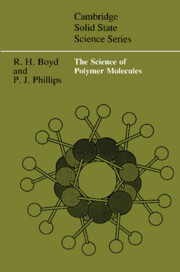Book contents
- Frontmatter
- Contents
- Preface
- 1 Polymerization: an overview
- 2 Molecular weight and molecular weight distribution
- 3 Molecular weight determination
- 4 Polymerization: kinetics and mechanism
- 5 Three dimensional architecture: conformation and stereochemical configuration
- 6 The statistical behavior of conformationally disordered chains
- 7 The interacting bond model for the average properties of coiling chains
- 8 Rubber elasticity
- 9 Solutions
- References
- Index
8 - Rubber elasticity
Published online by Cambridge University Press: 29 October 2009
- Frontmatter
- Contents
- Preface
- 1 Polymerization: an overview
- 2 Molecular weight and molecular weight distribution
- 3 Molecular weight determination
- 4 Polymerization: kinetics and mechanism
- 5 Three dimensional architecture: conformation and stereochemical configuration
- 6 The statistical behavior of conformationally disordered chains
- 7 The interacting bond model for the average properties of coiling chains
- 8 Rubber elasticity
- 9 Solutions
- References
- Index
Summary
If one end of a slip of Caoutchouc be fastened to a rod of metal or wood, and a weight be fixed to the other extremity, in order to keep it in a vertical position; the thong will be found to become shorter with heat and longer with cold.
Gough, 1805A material that can be deformed quickly to several hundred per cent strain, recovers rapidly and completely upon removal of the stress and is capable of having the process repeated numerous times is described as rubbery or elastomeric. The possibility of this behavior is due to the flexible long chain nature of polymer molecules and presents a type of response to mechanical deformation that is fundamentally quite different from the response given by rigid materials such as metals, ceramics and glassy or semi-crystalline polymers. This behavior is often called ‘entropy elasticity’ in contrast to the ‘energy elasticity’ of more familiar materials. The resistance to deformation is due largely to an entropy decrease rather than an energy increase. Entropy elasticity demonstrates itself in easily observed thermodynamic behavior such as the contraction of a stretched rubber band with increasing temperature as described by Gough (1805) in the quotation above. In this chapter, the contrast of energy vs entropy elasticity in thermodynamic behavior is developed. Then the molecular theory of rubber elasticity is discussed and its applicability to real elastomers is considered. Rubber elasticity is intimately connected with the presence of a network.
- Type
- Chapter
- Information
- The Science of Polymer Molecules , pp. 266 - 329Publisher: Cambridge University PressPrint publication year: 1993



